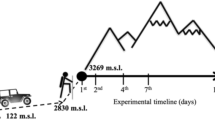Abstract
The aim of our study was to compare and assess the effectiveness of antioxidant mixtures on the erythrocytes (RBC) of adult male albino rats (Wister) subjected to simulated intermittent high altitudes—5,100 m (AL1) and 6,700 m (AL2)—to induce oxidative stress (OS). To achieve our objective, we pre-supplemented four sets of animals with different antioxidant mixtures [vitamin E (vit.E; 50 IU/kg BW), vitamin C (vit.C; 400 mg/kg) and l-carnitine (400 mg/kg)] in different combinations [M1 (vit.E+vit.C), M2 (vit.C+carnitine), M3 (vit.E+carnitine) and M4 (vit.C+vit.E+carnitine)] for 30 days prior to as well during exposure to intermittent hypobaric hypoxia (IHH). Membrane instability, in terms of osmotic fragility and hemolysis, decreased in RBCs of supplemented animals. There was a significant increase in the activity of glutathione peroxidase in the RBCs of supplemented animals. We confirmed OS imposed by IHH with assays relating to lipid [thiobarbituric acid reactive substances (TBARS) and lipofuscin (LF)] and protein (carbonyl, PrC) oxidation, and found a positive correlation between PrC and hemolysis, with a decrease in both upon supplementation with M3 and M4 mixtures. Fluorescence microscopic observation showed a maximum decrease in the LF content in rats administered M4 and M1 compared to those on M2 and M3 mixtures at both altitudes. We suggest that multiple antioxidant fortifications are effective in overcoming increased OS experienced by RBCs at high altitudes.





Similar content being viewed by others
References
Adams S, Green P, Claxton R, Simeox S, Williams MV, Walsh K et al (2001) Reactive carbonyl formation of oxidative and non-oxidative pathways. Front Biosci 6:17–24. doi:dxdoi.org/102741/Leeuwen
Asha DS, Subramanyam MVV, Vani R, Jeevaratnam K (2005) Adaptations of the antioxidant system in erythrocytes of trained adult rats: impact of intermittent hypobaric-hypoxia at two altitudes. Comp Biochem Physiol (Part C) Environment Science 140:59–67. doi:10.1016/j.cca.2005.01.003
Asha DS, Vani R, Subramanyam MVV, Reddy SS, Jeevaratnam K (2007) Intermittent hypobaric hypoxia-induced oxidative stress in rat erythrocytes: protective effects of vitamin E, vitamin C and carnitine. Cell Biochem Funct 25:221–231. doi:10.1002/cbf.1344
Bakonyi T, Radak Z (2004) High altitude and free radicals. J Sports Sci Med 3:64–69
Bernabucci U, Ronchi B, Lacetera N, Nardone A (2002) Markers of oxidative status in plasma and erythrocytes of transition dairy cows during hot season. J Dairy Sci 85:2173–2179
Cooper CE, Vollard NBJ, Choueiri T, Wilson MT (2002) Exercise, free radicals and oxidative stress. Biochem Soc Trans 30:280–285
Dodge JT, Mitchell C, Hanahan DJ (1963) The preparation and chemical characteristics of hemoglobin-free ghosts of human erythrocytes. Arch Biochem Biophys 100:119–130. doi:10:10166/0003-98963.90042-0
Dubinina EE, Gavrovskaya SV, Kuzmich EV, Leonova NV, Morozova MG, Kovrugina SV et al (2002) Oxidative modification of proteins: oxidation of tryptophan and production of dityrosine in purified proteins using fenton’s system. Biochemistry 67:343–350
Everse J, Hsia N (1997) The toxicities of native and modified hemoglobins. Free Radic Biol Med 22:1075–1099. doi:10.1016/s0891-5849(96)00499-6
Flohe L, Gunzler W (1984) Assays of glutathione peroxidase. In: Packer L (ed) Methods enzymol. Academic, Orlando, pp 114–121
Gallagher PG, Forget BG, Lux SE (1998) In: Nathan DG, Oski FA (eds) Hematology of infancy and childhood. Saunders, Philadelphia, pp 544–564
Ghiselli A, Serafini M, Natella F, Scaccini C (2000) Antioxidant capacity as a tool to assess redox status: critical view and experimental data. Free Radic Biol Med 29:1106–1114. doi:10.1015/s0891-5849(00)00394-4
Hawkins CL, Davies MJ (2001) Generation and propagation of radical reactions on proteins. Biochim Biophys Acta 1504:196–119. doi:10.1016/s0005-2728(00)00252-8
John S, Kale M, Rathore N, Bhatnagar D (2001) Protective effect of vitamin E in dimethoate and malathion induced oxidative stress in rat erythrocytes. J Nutr Biochem 12:500–504. doi:1016/s0955-2863(01)00160-7
Kraus A, Roth HP, Kirchgessner M (1997) Supplementation with vitamin C, vitamin E or β-carotene influences osmotic fragility and oxidative damage of erythrocytes of zinc-deficient rats. J Nutr 127:1290–1296
Kondo H, Takahashi M, Niki E (1997) Peroxynitrite-induced hemolysis of human erythrocytes and its inhibition by antioxidants. FEBS Lett 413:236–238. doi:10.1016/s0014-5793(97)00922-8
Lowry OH, Rosenberg NJ, Farr AL, Randall RJ (1951) Protein measurements with the Folin-phenol reagent. J Biol Chem 193:265–275. doi:10.1074/jbc.R000005200
Monji A, Morimoto N, Okuyama I, Yamashita N, Toshiro N (1994) Effect of dietary vitamin E on lipofuscin accumulation with age in the rat brain. Brain Res 634:62–68
Nagababu E, Rifkind JM (2000) Heme degradation during autoxidation of oxyhemoglobin. Biochem Biophys Res Commun 273:839–845. doi:10.1006/bbrc.2000.3025
Nagababu E, Chrest FJ, Rifkind JM (2003) Hydrogen-peroxide-induced heme degradation in red blood cells: the protective roles of catalase and glutathione peroxidase. Biochim Biophys Acta 1620:211–217. doi:10.1016/s0304-4165(02)00537-8
Niki E, Noguchi N (2004) Dynamics of antioxidant action of vitamin E. Acc Chem Res 37:45–51. doi:10.10021chin.200416265
O’Dell BL, Browning JD, Reeves PG (1987) Zinc deficiency increases the osmotic fragility of rat erythrocytes. J Nutr 117:1883–1889
Ohkawa H, Ohishi N, Yagi K (1979) Assay for lipid peroxidation in animal tissues by thiobarbituric acid reaction. Anal Biochem 95:351–358. doi:1016/0003-2697(79)90738-3
Ramazan MS, Ekeroglu SH, Dulger H, Algun E (2000) The effect of dietary treatment on erythrocyte lipid peroxidation, superoxide dismutase, glutathione peroxidase, and serum lipid peroxidation in patients with Type 2 Diabetes Mellitus. Clin Biochem 33:669–674. doi:10.1016/s0009-9120(00)00190
Rani PJA, Paneerselvam C (2001) Carnitine as a free radical scavenger in aging. Exp Gerontol 36:1713–1726. doi:10.1016/s0531-5565(01)00116-4
Senturk UK, Gunduz F, Kuru O, Aktekin MR, Kipmen D, Yalcin O et al (2001) Exercise-induced oxidative stress affects erythrocyte in sedentary rats but not exercise-trained rats. J Appl Physiol 91:1999–2004
Uchida K, Stadtman ER (1993) Covalent attachment of 4-hydroxynonenal to glyceraldehyde-3-phosphate dehydrogenase. J Biol Chem 268:6388–6393
Acknowledgments
The authors wish to acknowledge Prof. M.A. Yadugiri for editing the initial draft of this manuscript. This work was supported by grants received from the Department of Science and Technology [DST SP/SO/AS-58/2004].
Author information
Authors and Affiliations
Corresponding author
Electronic supplementary material
Below is the link to the electronic supplementary material.
ESM 1
(DOC 228 kb)
Rights and permissions
About this article
Cite this article
Vani, R., Shiva Shankar Reddy, C.S. & Asha Devi, S. Oxidative stress in erythrocytes: a study on the effect of antioxidant mixtures during intermittent exposures to high altitude. Int J Biometeorol 54, 553–562 (2010). https://doi.org/10.1007/s00484-010-0304-6
Received:
Revised:
Accepted:
Published:
Issue Date:
DOI: https://doi.org/10.1007/s00484-010-0304-6




